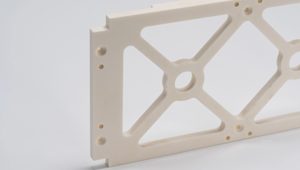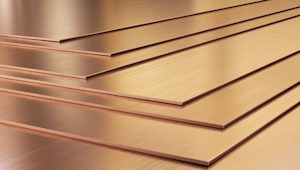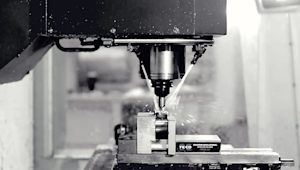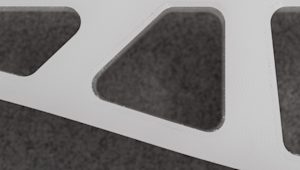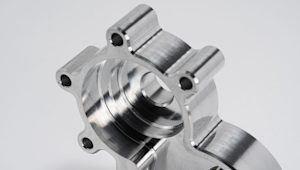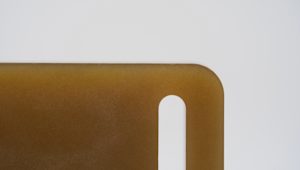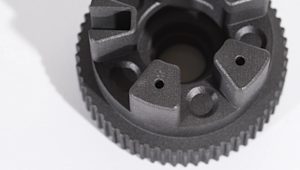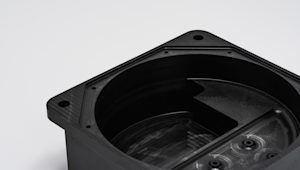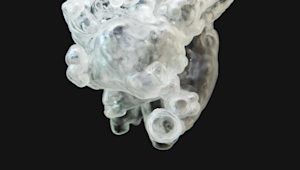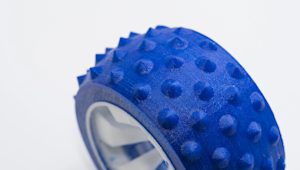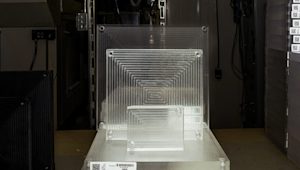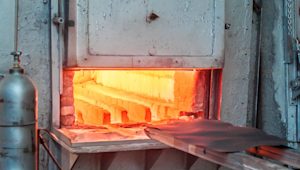There’s no denying the popularity of plastic as a manufacturing material. But what if you need to create a part that can withstand high temperatures? Here’s how to make sure that your parts can handle the heat. We have categorized some of the most common types of heat-resistant manufacturing materials into thermoplastics, thermosets, and elastomers.
Thermoplastics
Thermoplastics can be melted, reshaped, and recycled without significant degradation. Thermoplastics are used in a wide range of applications, from packaging and consumer goods to automotive and medical devices, due to their ease of processing and ability to be molded into complex shapes.
PEEK (Polyether Ether Ketone)
PEEK has exceptional mechanical properties, including high strength, stiffness, and wear resistance. Due to its high temperature resistance–it has a maximum operating temperature of about 250 °C–PEEK is also suitable for use in high-temperature environments, such as aerospace and automotive applications. PEEK also exhibits excellent chemical resistance, as well as resistance to UV radiation and abrasion.

PTFE (Polytetrafluoroethylene)
PTFE, more commonly known as Teflon, has a max operating temperature of about 260 °C. It is a high-performance, low friction engineering plastic with exceptional resistance to a wide variety of chemicals. It also has a very high melting point and dimensional stability.
It is often used in applications where precision and tight tolerances are required, such as in mechanical components, gaskets, and seals. Along with its chemical resistance, PTFE’s non-stick characteristics result in the material’s popularity in the packaging and food processing industries.

PEI (Polyetherimide)
PEI, also known as Ultem, has a max operating temperature of around 170 °C. It also has excellent dimensional stability, high strength, stiffness and long-term heat resistance. It also PEI offers excellent chemical resistance, and can withstand exposure to various chemicals, including acids, bases, and solvents, without compromising its structural integrity.
PEI exhibits high mechanical strength and rigidity, contributing to its use in demanding engineering applications. Its combined properties result in PEI being commonly used to manufacture medical devices, electrical connectors, and high-performance components in the automotive and aerospace sectors.
Elastomers
Elastomers are polymers with elastic properties. This means they can stretch and return to their original shape. Some, but not all, elastomers are heat-resistant. Not surprisingly, elastomers are commonly used in applications requiring flexibility, such as rubber bands, tires, and gaskets.
Silicone
Silicone is a synthetic polymer commonly used in applications where durability and flexibility are important. Depending on its composition, it can resist temperatures of up to 230 °C. It is also resistant to heat, cold, and chemicals, and is often used in extreme environments. Its rubber-like qualities make it easy to mold into complex shapes. It is also non-toxic and hypoallergenic, making it safe for use in medical and food-related applications.
Thermosets
Thermosets are materials that irreversibly cure, forming a solid structure that cannot be remelted. This process means that once their shape has set and cured, they cannot be reshaped or recycled. However, it also provides them with high thermal stability, chemical resistance, and mechanical strength.
Polyamides (PI)
Polyamides (PI) are high-performance polymers that exhibit excellent dimensional stability. This means they maintain their shape and size even when exposed to various environmental factors such as changes in temperature and humidity.
Polyamides also have exceptional thermal stability, and can withstand high temperatures without significant degradation. This makes them suitable for use in high-temperature environments, such as in jet engines and electrical insulation materials. Their high glass transition temperature, often exceeding 400°C, ensures they remain stable and retain their mechanical properties even under extreme heat
PIs are also chemical-resistant, enduring exposure to solvents, fuels, and other harsh chemicals without losing their integrity. This property makes them ideal for applications in chemical processing and in environments where they are likely to be exposed to corrosive substances.
Epoxy resins
Epoxy resins have a low coefficient of thermal expansion, which means that they undergo minimal dimensional changes with temperature fluctuations. This stability is a big advantage in applications that require high degrees of precision and tight tolerances, such as in the aerospace, electronics, and automotive industries.
Epoxy resins also offer superior mechanical properties and chemical resistance. They are commonly used as adhesives, coatings, and bases for composite materials, providing strong bonding and durable surfaces. Additionally, they can be used to create molds and tooling, as well as in the production of printed circuit boards (PCBs), thanks to their electrical insulation properties.
What manufacturing methods are best suited for heat-resistant plastics?
When you choose a manufacturing method for a heat-resistant plastics, you will need to consider factors such as the type of plastic you want to use, your part’s geometry, production volume, and cost constraints. In this section, we’ll take a look at our most popular manufacturing methods’ suitability for heat-resistant plastics.
Injection molding and heat-resistant plastics
Injection molding creates parts with excellent precision and surface finish, even if they have complex geometries. While high tooling costs make it less economical for low volumes of parts, it’s usually the first choice for large production batches (high-volume production).
Heat-resistant plastics like PEEK, PPS, and polyamides are well-suited for injection molding because they can withstand high processing temperatures.
CNC machining and heat-resistant plastics
CNC machining offers high precision and tight tolerances for almost all heat-resistant plastics. You can use CNC machines to create both simple and complex parts, especially in low to medium volumes.
3D printing and heat-resistant plastics
3D printing is often used for prototyping and low-volume production using heat-resistant plastics, including PEEK and PEI – especially those with complex, customized shapes. It offers great design flexibility and material efficiency.
The downside? 3D printed parts may require post-processing after printing and parts may have lower mechanical strength.
Manufacture heat-resistant plastic parts
To get an instant quote for custom parts, upload a CAD file and select from our huge range of manufacturing materials, including heat-resistant plastics. You can instantly compare pricing and lead times to suit your project.
For more information about selecting materials, read our articles about recommended materials for CNC machining, injection molding and 3D printing.
Frequently asked questions
What are heat-resistant plastics?
Heat-resistant plastics maintain stability and strength at high temperatures, ideal for industrial applications.
Which plastics are most heat-resistant?
Polyamides (PI), PTFE, and PEEK are among the most heat-resistant plastics
What temperatures can heat-resistant plastics withstand?
Heat-resistant plastics can withstand temperatures up to 400° C, depending on the material.
Can heat-resistant plastics be machined?
Yes, they can be machined using standard techniques with appropriate tools.
How do heat-resistant plastics compare to metals?
Plastics offer lower weight and corrosion resistance while maintaining strength at high temperatures (up to 400 °C), depending on the material.








